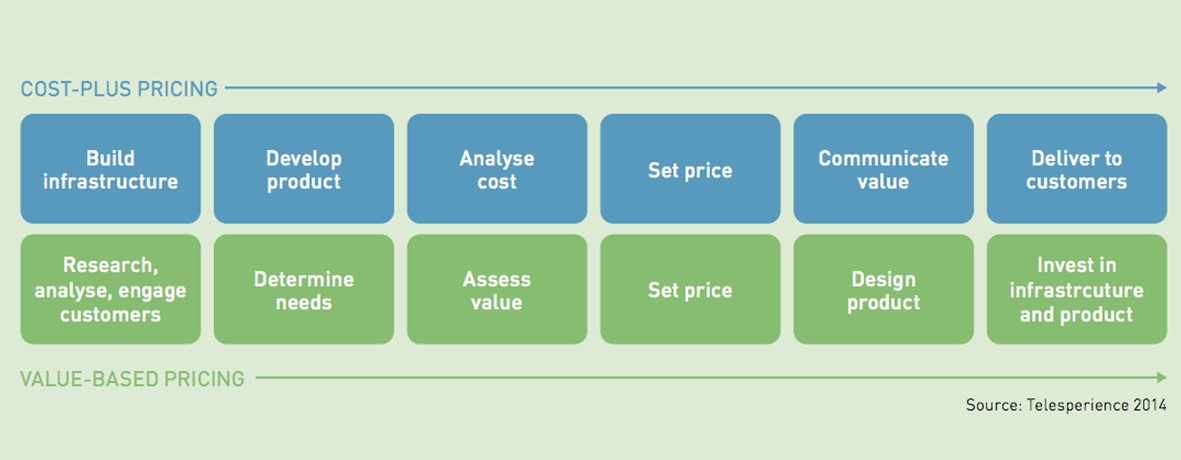#1: The rise of the hybrid pricing model
Over the past few years, the way in which subscribers use and pay for their phones has undergone a dramatic change: data usage has overtaken voice usage, and postpaid has overtaken prepaid as the payment plan of choice, thanks in part to the attractiveness of pay monthly tariffs.
It might be logical to assume that prepaid will now finally die out as a new generation of consumers favour the larger data allowances of postpaid plans, but whilst postpaid has historically been seen as the more attractive pricing model for operators, the race to the bottom via continual discounting has left operators struggling for revenues. Despite the massive uptake in smart device usage and network traffic, profits are dropping, margins are being squeezed and there is increasing pressure on operators to invest in their operations so they can compete in the digital ecosystem.
Both prepaid and postpaid have their challenges, then. Instead, operators need to take a long, hard look at their pricing strategies. Rather than basing pricing on what the product costs to deliver, known as a cost-plus approach, value-based pricing sets pricing according to the perceived customer value of the product. It is driven by a deep understanding of what customers need and value, and of their ability and willingness to pay, but it can ensure profitability no matter what level of competition in the market when linked to the needs of the customer.
In the UK, Dixons Carphone listened to millions of its customers’ needs and wants over a period of years, identifying some common challenges, including a desire for greater flexibility in plans and accessing data and services on the move. Its new MVNO network, iD Mobile, launched last year, is now aiming to roll out a number of different plans that address these concerns.
This is a sensible approach. If prepaid and postpaid pricing strategies aren’t working, then we need to find a third way, a hybrid approach, that puts the customer first. Operators should start from the requirements of the customer – understanding what the customer wants and needs – and then meeting those. This means that the value of the product determines its price, not what the service provider spends on creating the product.
A hybrid pricing model prices for the customer, not for the business. New pricing strategies can help service providers extract more value from their offerings and encourage greater focus on profit and innovation. The challenge for service providers in 2017 is not simply to transform the way they price services, but to identify how they can work with third parties and share value with them, and how they can gain a better understanding of customer preferences, behavioural trends and context.

#2: Mobile data as the new retail reward currency
Retailers’ increasingly squeezed margins are having a particularly amplified effect on loyalty and rewards programmes. These days, many people own more than one card, meaning they’re not loyal at all, and as well as remaining tied to price, there is some suspicion over the way in which supermarkets use customer data gathered from the cards.
Retail analysts Conlumino reported that, “Loyalty cards, among other things, provide a great source of information and detail about consumer preferences and habits. The challenge for retailers is to be able to tap into these insights and use them effectively in their marketing and promotional activity.”
A successful customer loyalty or rewards programme should be attractive enough for customers to change their behaviour but not so great as to erode margins, creating an incentive that encourages customers to behave in a particular way . The solution is to use a rewards currency that is conceptually removed from money, but which is also appreciated by the customer regardless of their profile and unaffected by depressed retail margins.

Andy Peers,
VP Strategy
& Innovation,
MDS
Retail MVNOs – that is mobile services operated by retailers – have the ultimate consumer reward program in their hands. Mobile data is therefore a powerful offering for a consumer rewards programme, especially with European mobile data usage predicted to grow from 0.9GB in 2014 to 5.7GB in 2019. Many retailers already have a mobile offering with a significant customer base, whilst the gross margin on data is around a very healthy 30%, plus giving away more of it once a relationship with the customer has been established is relatively cheap.
Unlike petrol, data is not location-specific, nor is its value based on the cost of delivery but on its perceived value to the customer. Moreover, on a modern digital MVNO platform, mobile usage yields many more marketing datapoints that a typical loyalty card yet the convenience of mobile services makes consumers far more tolerant of information being surrendered.
Better still, mobile and digital services offer exceptional opportunities for differentiation and further customer engagement. Offers can be sent to customers when they’re not in the store, or in real-time at the point of sale. An app can help customers see their rewards tot up in real-time, as well as creating a brand presence permanently in the customer’s hands: somewhere they will regular check their data usage, get retail offers and manage their mobile account. There’s no single solution in loyalty; and digital goods should be seen as an add-on to, not a replacement for, petrol, financial services, special offers and more. But as an offering that genuinely changes customer behaviour whilst protecting the all-important product margin, mobile data is a marketer’s dream.
#3: Real-time trust in the B2B world
Whilst real-time experience gets talked about in the consumer world, the effects of bill shock in a B2B environment could be far more disastrous. Research shows that typical perceptions of the TCO of enterprise mobility are grossly inadequate: the difference between perception and reality can be out by as much as 116% . On top of that, Informa estimates that operators can write off as much as 40% of data roaming charges as bad debt.
The issue is that the actual TCO figure includes cost factors that are too often forgotten, one of which is unexpected extras such as roaming bill shocks or excessive data usage. Carrier costs account for around 50% of the TCO in both the UK and the US, and most enterprises only factor in predicted carrier costs when they look at subscriber plans, failing to account for unexpected extras such as roaming bill shocks or excessive data usage. Clearly the B2B world needs real-time transparency now more than ever.
Real-time offers a way for enterprises to get their employees to take responsibility for their data usage. At MDS, conversations with our B2B customers show that their expectations mirror those of the B2C world’s, with the same requirements for control and transparency.
Were real-time changing to be seen as something that’s not just exclusively for the consumer world, the impact on a single account with thousands of employees would have a bigger effect on what is becoming a thin margin business.
The same is also true for the under-served SME market where, in the UK, companies with five employees or more spend on average 19 times what an average UK household spends. This is spending on basic telecoms services only, and shows that there is great market potential should value-added services also be factored in. Around half of European SMEs would prefer to receive their telecoms services from a single supplier, so by consolidating communications spending by offering multiple services, CSPs could increase their revenues from SME customers.
But there is still the issue of trust to take into account. If you, as a service provider, lose the trust of a single subscriber, they will move to another provider. In a B2B scenario, this issue could cost multiple customers in one go. And if you’re looking to sell additional services, removing bill shock is the first thing you need to do.
With B2B operators and MVNOs selling into a diverse set of services, customers are more likely to buy more services from a single point when transparency and trust have been established. In 2017, the B2B world should expect to look forward to a better customer experience with real-time billing and charging, one that puts them back in control, whatever the size of their enterprise.
About The Author:
Andy Peers is VP Strategy and Innovation at MDS. With 25 years’ experience in the telecoms industry with a broad background in IT, finance, revenue assurance and service management, Andy is responsible for defining the company strategy and future direction. Through his work in Australia, the US and Europe, he has extensive international telecoms experience, working on major projects with operators, service providers and MVNOs.



















